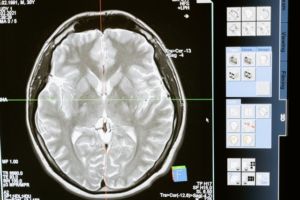Anywhere you go, you see people staring down at their phones. The phrase “text neck” was coined to describe the phenomenon of more people experiencing neck pain because of technology use. What text neck really describes is a strain on the neck structures that can result in an unhealthy change of the spine’s curvature over time. The part of your spine that makes up your neck is called the cervical spine, and it’s one of the most important spinal curves. Here’s why text neck can be a serious problem and what you can do to avoid it.

The Cervical Spine and Your Brain
The cervical spine curves inwards towards the front of your body. This curve balances out the other curves in your spine and helps to protect the neck from damage. All the curves in your spine aid with flexibility and provide shock absorption. This design also helps energy flow freely through your spinal cord and onto the rest of your body.
Protecting the spinal cord from stress and strain is one of the spine’s primary jobs. The cervical spine connects to your skull and protects your brain stem. That sounds important because it is. The brainstem is the part of your brain that connects to your spinal cord. It is responsible for regulating the autonomic functions essential to life. That means things like breathing, heart rate, swallowing, and blood pressure. It also controls facial sensation, coordination, and balance. In addition, the brainstem contains your reticular activating system or RAS– a network of neurons that control your sleep-wake cycles.
Neurosurgeons have found that reductions in the neck curve can stretch the cervical spinal cord and the brain stem up to 1.68 inches. This puts an incredible amount of stress on the nervous system that is passed to every nerve that branches from the spinal cord. Patients with less than 20% of their natural neck curve can experience a variety of symptoms, from chronic headaches and muscle pain to tinnitus and insomnia. Extreme loss of the cervical curve can cause double vision and difficulty swallowing.

Texting Isn’t The Only Cause
The phrase text neck is somewhat misleading. Cervical curvature problems also commonly result from car accidents (whiplash), military service, chronic bad posture (often in front of a computer), and congenital disabilities or diseases.
Some of these causes are preventable, while others are not. A bad whiplash injury is bound to cause some loss of the cervical curve, but prompt treatment can keep this condition from worsening or becoming permanent.

How to Keep Your Curve
Everyday habits can go a long way towards protecting your cervical curve. One of the most important parts of an ergonomic working environment is placing your computer screen at eye level. Looking down for eight hours a day will result in neck problems over time. Of course, curbing your urge to stare down at your phone for long hours is also helpful. When you have to scroll or watch something on your phone, hold it at eye level. Buying a case or accessories that make your phone more comfortable to hold can help with this.
Posture in other situations also impacts your neck. Try to stand upright with your shoulders rolled slightly back and your head in a neutral position between your shoulders. Keep good posture while working out, sitting, and walking.
Since we spend a third of our lives sleeping, our sleep positioning, mattress and pillow can help or hurt our spine health. Make sure to support your neck while you sleep. One of the easiest ways to do this is with a U-shaped pillow. There are also many pillows designed specifically for neck support. Try out more than once to see which one works best with your mattress and your sleeping position. Side sleepers need a pillow that fills the gap between their shoulder and head, while back sleepers can look at pillows that provide raised support towards the front of the pillow.
Keeping your back and neck muscles strong, eating a healthy diet, and not smoking will lower your risk of neck and back pain.

Treatments for Text Neck
Many people with cervical curvature problems experience muscle pain, spasms, and neurological symptoms like tingling or numbness. When the spinal curve gets thrown off, it strains all the soft tissues around it. Some muscles and ligaments can become overstretched while others are shortened. Trigger points often develop and cause chronic pain. A combination of treatments is needed to pull all the structures of the neck back into their proper places.
Strengthening exercises, posture rehab, adjustments, and stretches can be prescribed to gently move the spine back into a proper curve while helping the muscles support that curve. Acoustic compression– a treatment that uses sound waves to stimulate deep tissues– can assist with adhesions and trigger points.
Many patients with curvature issues also have damage to one or more discs in the cervical spine. In these cases, spinal decompression therapy can be useful. Decompression therapy is a type of motorized traction that gently stretches the spine to create negative pressures between vertebrae. This increases the flow of blood and oxygen to aid healing and moves bulging or herniated discs back into place.
Since the curves of the spine work together as a system, people with long-term cervical curve loss often have problems with the other curves of their spine. The body tries to compensate by changing the curves of the thoracic and lumbar spine. Due to this, many patients with neck pain also struggle with back pain. The same treatments used for neck problems can be used on the whole back to correct curvature and align the spine.
Treatment for Neck Pain in Michigan
At Burkhart Chiropractic, we have extensive experience treating clients with neck pain and cervical curve deficits. Don’t let neck pain get in the way of your holiday plans. Come in for a consultation to find out more about our safe and effective treatments.



